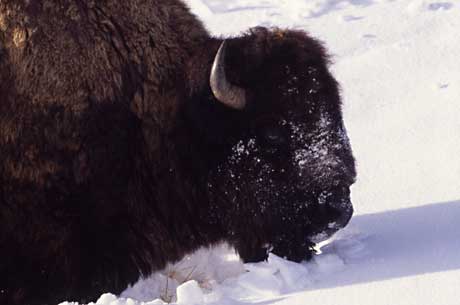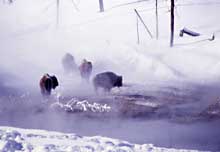
|
Lobby > Exhibits > Hot Spring Ecology > Wildlife > Case Study: Bison WildlifeCASE STUDY: BISON Archaeological evidence shows that bison have lived in the central part of Yellowstone National Park for approximately 10,000 to 12,000 years. The thermal advantages of the region have provided critical winter habitat. A bison's massive hump supports strong muscles that allow the animal to use its head as a snowplow to search for food during the winter. However, as the storms accumulate, so much energy must be expended to clear enough ground to forage that the animal's survival may be threatened. 
During the winter, most of the park's central bison herd congregate in the relatively mild hydrothermal areas along the Firehole and Madison Rivers. Less snow collects on the warm ground and plants may grow year-round.
Next Case Study: Trumpeter Swans | Next Section: Plants |
|
||||||||||||||||||||||||||||||
 Even in hydrothermal areas, however, the amount of energy a bison must use to find food
can change on a daily or weekly basis. If there are long periods of mild temperatures,
the snow-free areas around hydrothermal areas expand in size, only to shrink again rapidly
when the new storms arrive.
Even in hydrothermal areas, however, the amount of energy a bison must use to find food
can change on a daily or weekly basis. If there are long periods of mild temperatures,
the snow-free areas around hydrothermal areas expand in size, only to shrink again rapidly
when the new storms arrive.

